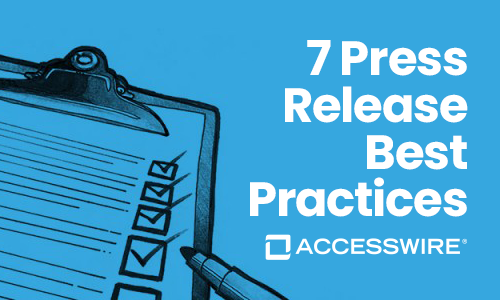A Guide For Crisis Communications Planning
Nowadays, it seems that we can find a crisis situation everywhere we look. Think of what happens daily in newspapers and on news networks: The worldwide economy is in crisis; our political system is in trouble; Earth’s climate is in peril; our educational system is flawed–– there seems to be a never-ending list of things that are difficult to handle all at once.
With so many other things going on, it’s easy to forget that bad things can also happen in the business world. What’s also easy is thinking that your company is safe from a crisis.
Think again.
The one thing in business that’s true for every company imaginable is that there is no immunity from something terrible happening. However, there is something you can do ahead of time that might save your business, its employees, and the public.
Plan for the worst-case scenario.
Why to Develop a Crisis Communications Plan
Developing a crisis communications plan for something bad that hasn’t happened yet might sound weird, but just ask any corporate president or CEO that’s gone through a crisis whether they see value in having a framework in place for the unexpected. (“No” would be the wrong answer.)
Understanding what can happen without a crisis communication plan does not seem like anything any group of C-Level leaders would want to deal with:
- Operational responses to a crisis will quickly become unglued if employees are not brought up to speed immediately and do not know precisely what to do to fix the situation.
- Shareholders, stakeholders, and/or the general public will become reactively angry, confused, and/or negative if they are not “in the know” about the origins of the problem and what the company’s leaders are doing to overcome the crisis.
- The company’s leadership will quickly lose the confidence of its shareholders, stockholders, employees, and customers.
- The length of time it takes to “right the ship” will, by default, be longer than it would if a crisis communications plan were in place.
- The damage to a company or brand will be significantly worse without a crisis management plan in place, as will its bottom line.
Yet another business certainty is that doing nothing ahead of any unforeseen negative circumstance severely handicaps a company’s ability to respond to a crisis successfully. This crisis communications guide will walk you through the planning steps and post-crisis actions, so your business will not be completely caught off-guard.
1. Getting Started: Departmental Analysis
One of the first things a company’s leadership needs to do is to figure out where the vulnerabilities are within the organization. To start the process of putting a crisis response plan in place is to thoroughly analyze each department and find out what works well and what doesn’t.
Improvements can always be made to keep any business safer from a PR disaster; performing a deep analysis of every part of an organization’s day-to-day operations is the first step a leadership team needs to tackle. You should leave no stone unturned from IT to accounting, marketing to product or service safety, and employee satisfaction to manufacturing.
Once you have identified your organization’s weaknesses, it’s time to implement a plan to bring each department to a point where they are as crisis-proof as possible.
2. Identify Crisis Communicators
Ideally, the president or CEO of a business is typically the face of the organization and will be front-and-center for any kind of crisis, but they need backup. During a crisis, companies will need someone with a deep institutional understanding and knowledge of the inner workings of the situation.
Think of it this way: You wouldn’t expect the head of your IT team to know the details of an accounting crisis, nor would you think that an HR director can easily explain a situation involving a data security breach and how it happened.
The best person to set the communications plan in motion for all target audiences, including journalists and media outlets, is the head of your Public Relations department, public information officer, or the CIO if you have one. If your selected point-person for running your plan doesn’t have experience in crisis communications – and many do not, luckily – you should either have a PR agency identified or hire one as quickly as possible; the longer you wait to put your plan into action, the longer it will take for your company to recover. Thanks to the advent of the internet, you don’t necessarily need an agency located near your business’s headquarters.
In a worst-case scenario, your selected crisis communicators may also need backup in the form of legal counsel. Does that mean you should ditch your crisis communications plan? No way. Your legal representatives work for and with your company, not the other way around. That said, not having legal representation is a risky idea, particularly regarding potential charges or fines that could be levied against your company or any of its employees – but those situations are thankfully rare.
3. Give Your Crisis Communicators Media Relations Training
Keep in mind that the people who make up your Crisis Communications Team should be the only people allowed to speak publicly about whatever is happening at your company.
But don’t assume that all C-Level execs or department directors are prepared to speak publicly about bad news, or good news, for that matter. Professional speaking, particularly to the media, is a learned skill that must be honed by your designated communicators. Again, if your in-house PR team doesn’t have experience in media relations, find an agency that offers that.
If you do have someone who can teach media relations to your crisis communication team, start the training ASAP. The first exercise in that training comes from sitting down with your communicators and developing a list of every possible question that could be asked about this event. As usual, the who/what/when/where/why/how should be covered, as well as talking points about the steps your company is taking to emerge from the crisis as quickly as possible.
The training should also teach your crisis team how to speak to journalists and news media outlets. Have them practice daily, if possible, to perfect their talking points and delivery, whether their answers are delivered over the phone or in front of TV cameras. Most importantly, make sure they listen to or watch themselves as they practice, so they can change their messaging style, tone of voice, saying “um” too much, or whatever else needs to be addressed in their delivery.
One point to emphasize with your crisis communicators: This is not an opportunity for them to promote your troubled company––it is an opportunity to communicate the facts that could potentially save the company from further damage or ruin.
4. Set Up A Monitoring and Notification Process
In this technologically-driven Communication Age we currently live in, you have a multitude of ways to instantly reach out and contact your key stakeholders using one device. Your pre-selected stakeholder data can be established in whatever communication channels or platform you use for emergency notification. You can even keep trying to reach them until they confirm receipt of your message (such as requiring the recipient to press a certain number on a phone keypad or whatever other methods you can add). Rapid internal communication is a high-priority component of your crisis prevention, emergency management, and emergency response plan.
Monitoring feedback from all stakeholders, and the public, is also key to your planning because it can allow you to quickly adjust your tactics or strategy, if necessary. One of the most popular (and free) monitoring comes via Google Alerts. Still, other platforms can monitor any and all feedback on social media, such as Hootsuite. If you want to take a deeper dive into your crisis monitoring, there are plenty of subscription options that can add report results in various formats. Regardless of your choice, your communications team will need to be trained in advance on how to use your selected platform. Typing up digital instructions for your crisis management team is also a good idea.
Training for your team is not the only group you’ll need to include; selected staff members who have direct contact with your company’s stakeholders, such as customer service or sales reps, should also know how to report whatever they are hearing or seeing in real-time to your designated crisis communicators.
5. Speaking of Stakeholders… Identify Who They Are
While you are doing all the advanced preparation in your crisis communication planning, be sure you create a list of your internal and external stakeholders that you know will be speaking about what’s going on with your company to people that might not be on your list of crisis contacts. Ensure that this audience of stakeholders will receive updated messages that you want them to share. Doing this can keep the negative information from getting too out of hand.
Designate one or two people on your crisis team who will be in charge of delivering these messages as soon as they are developed and approved.
6. Prepare Holding Statements
The messaging process, which you have been working on since the beginning of creating your crisis plan, should also include holding statements, which are direct talking points that you can deliver from the outset. Like the other message, holding statements can be used as specific talking points for all your previously identified departmental vulnerabilities and external factors, such as national or international natural disasters.
Most companies have recently experienced creating such external messages with the advent of the Covid-19 pandemic, as situations such as temporary or permanent location closures, customer service centers, supply chain delays, etc., have arisen. Another vital holding statement you should prepare in advance is when your company has operations in unsafe regions of the world; one example would be the current war in Ukraine.
Of course, you should never take weather-related, man-made, and/or geographic disasters lightly. Winter blizzards or deep cold snaps, weather-related power outages or grid failures, earthquakes, floods, tornado strikes, and wildfires spring to mind; sadly, so do workplace or public acts of violence. The safety of your internal and external audiences can depend on your team staying up-to-date on what’s going on in every region where your business operates. Create templates with enough blank space to quickly fill in, adding statements like:
- “We have activated our crisis response plan to make sure our employees and [residents of] [customers] [business partners] remain safe…”
- “We are monitoring the situation closely and will provide updates on our website as they become available…”
- “Our thoughts are with the people in and around this region, and we hope they remain safe…”
- “We have set up a toll-free number…”
- “For your safety, we recommend you should not [travel to/leave] this area…”
- …and so forth.
We understand that creating a crisis communications plan is an undertaking that requires time and involvement commitments for you and your colleagues; however, throwing together a hasty plan as a crisis unfolds should be avoided. Time is of the essence, and your resources may be spread thin; the last thing your company will want is to be unprepared for any foreseeable event. Planning as thoroughly as you can for the unexpected can not only save your company from undue damage––it might save lives. Staying on the offensive of your crisis is far more critical than operating defensively.
MID- AND POST-CRISIS ACTIONS
7. Perform A Crisis Assessment
According to Wikipedia, American scholar Suzanne Massie met with Ronald Reagan many times while he was president between 1984 and 1987. She taught him the Russian proverb, “Doveryai, no proveryai” (Доверяй, но проверяй), which means “trust, but verify.”
During any crisis, verifying information is critical.
Verification via a credible source is the very first thing you and your crisis communication team should do as soon as a situation is brought to your collective attention. And again, we emphasize that hastily-developed communications, particularly at the start of a crisis situation, can be ineffective, inefficient, and can cause more harm than good.
8. Keep Adapting And Updating Prepared Crisis Templates
Once a critical situation develops, you should still rely on your pre-written templates and add verified information that will keep your stakeholders, employees, and everyone else updated. Make sure your stakeholder updates are straightforward and easy to understand – limit each update to only two or three main messages. You should keep adapting your communications for your various audiences, such as employees, the public, and news organizations.
Just keep the updates coming. Not communicating to your stakeholders or other pre-identified audiences during a crisis can be interpreted as an admission of guilt or lack of accountability. The last thing you need is to have your response judged by the Court of Public Opinion. Staying out front and being accountable if the situation is due to something or someone attached to your business will keep the narrative in your hands. Never distribute false information, or respond to any journalist or media outlet with, “I don’t know.” Instead, say something like, “That’s a great question, but unfortunately, I am not 100% sure of the answer right now...give me your direct contact information, and I will update you as soon as our crisis team has an answer.” Then, respond as soon as you have that verifiable answer.
9. Lessons Learned: A Post-Crisis Review
There is one more thing you can rely on: A company crisis will teach you and your colleagues a lot.
Once the dust has settled and you are past the crisis, you and your company’s leadership team should set aside a time where you can review all of the pre-and post-crisis actions you took – and the missed opportunities you did not take. If you properly prepare crisis communications in advance, you will likely discover how many actions were performed well. Realize that even though you have prepared for a crisis situation, you will find areas where your response could have been better. Once you understand that the likelihood of your crisis communications plan will not be without shortfalls, you can make sure those weaknesses or missed opportunities are addressed and improved upon, should there ever be another threat to your reputation, continuity, and business operations.
One More Thing….
Keep in mind that press release distribution is an excellent way to get your news into the hands of the right people, journalists, and media outlets. ACCESSWIRE is available 24 hours a day to help you reach your target audiences in good AND bad times. Our platform is user-friendly, and our press release distribution network and global coverage will help you communicate as far as your message needs to go. To schedule a demo, click here.
Similar Blog Posts
PRODUCTS
ACCESSWIRE | All Rights Reserved




